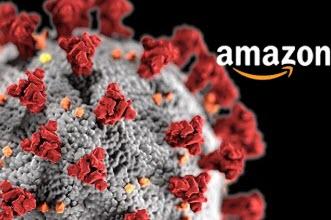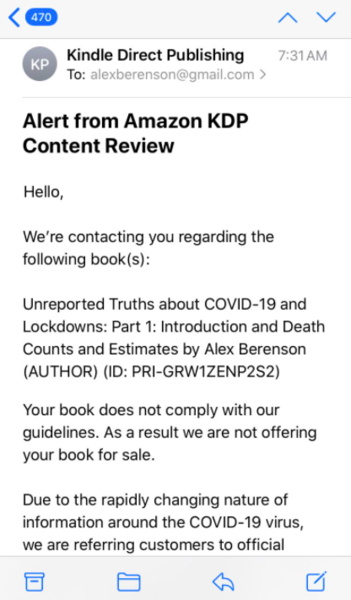“Unreported Truths” – This Is The COVID-19 Book That Amazon ‘Quarantined’
Tyler Durden
Fri, 06/05/2020 – 23:20
Via RealClearInvestigations.com,
Former New York Times reporter Alex Berenson has developed a wide following on Twitter for detailed posts that challenge some mainstream reporting and government declarations about COVID-19.
THEY CENSORED IT! It is based entirely on published government data and scientific papers. It doesn’t say coronavirus isn’t real or doesn’t kill people (in fact, the worst-case death toll is likely to be striking to people). And Amazon won’t run it.
— Alex Berenson (@AlexBerenson) June 4, 2020
Read the full thread here.
Thursday morning he tweeted that Amazon had refused to offer for sale his self-published book, “Unreported Truths about COVID-19 and Lockdowns Part 1: Introduction and Death Counts and Estimates.”
Among those responding in outrage over what they called blatant censorship were SpaceX CEO Elon Musk (“This is insane @JeffBezos”) and journalist Glenn Greenwald. And late Thursday Berenson reported that Amazon had backed off and is now offering the book for sale on Kindle.
Before Amazon reversed itself (calling its earlier move an “error,” according to Fox News), RealClearInvestigations asked the award-winning novelist to elaborate on his experience. Here’s his response, followed by an excerpt from the book:
By Alex Berenson
June 4, 2020
The booklet was the first in a series of coronavirus pamphlets I plan to put out covering various aspects of the crisis. Readers of my Twitter feed encouraged me to compile information in a more comprehensive and easier-to-read format, and when I polled people on Twitter to ask if they would be willing to pay a nominal fee for such a pamphlet, the response was strong.
Originally I only planned to write one, but I had so much information I realized that the booklet would be an awkward length – longer than a magazine article but shorter than a book. Also, doing so would take too long, and I wanted to put it out quickly. So I decided to split the booklet into pieces. Part 1 included an introduction and a discussion of death coding, death counts, and who is really dying from COVID, as well as a worst-case estimate of deaths with no mitigation efforts.
It is about 6,500 words, and I planned to sell it for $2.99 as an ebook or $5.99 for a paperback. It is called “Unreported Truths about COVID-19 and Lockdowns: Part 1, Introduction and Death Counts and Estimates.”
I created covers for both and uploaded the book. I had published Kindle Singles (Amazon’s curated program for short Kindle pieces, which now focuses more on fiction from established writers), so I was relatively familiar with the drill. I briefly considered censorship but assumed I wouldn’t have a problem because of my background, because anyone who reads the booklet will realize it is impeccably sourced, nary a conspiracy theory to be found, and frankly because Amazon shouldn’t be censoring anything that doesn’t explicitly help people commit criminal behavior. (Books intended to help adults groom children for sexual relationships, for example, should be off-limits – though about 10 years ago Amazon did not agree and only backed down from selling a how-to guide for pedophiles in the face of public outrage.)
I didn’t hear anything until this morning, when I found the note I posted to Twitter in my inbox (shown below).
Note that it does not offer any route to appeal. I have no idea if the decision was made by a person, an automated system, or a combination (i.e. the system flags anything with COVID-19 or coronavirus in the title and then a person decides on the content). I am considering my options, including making the booklet available on my Website and asking people to pay on an honor system, but that will not solve the problem of Amazon’s censorship. Amazon dominates both the electronic and physical book markets, and if it denies its readers a chance to see my work, I will lose the chance to reach the people who most need to learn the truth – those who don’t already know it.
Here are the first 1,000 words of Chapter 1:
Maybe the most important questions of all:
How lethal is SARS-COV-2?
Whom does it kill?
Are the death counts accurate – and, if not, are they over- or understated?
Estimates for the lethality of the coronavirus have varied widely since January. Early Chinese data suggested the virus might have an “infection fatality rate” as high as 1.4 – 2 percent.
A death rate in that range could mean the coronavirus might kill more than 6 million Americans, although even under the worst-case scenarios some people would not be exposed, and others might have natural immunity that would prevent them from being infected at all.
As we have learned more about the virus, estimates of its lethality have fallen. Calculating fatality rates is complex, because despite all of our testing for COVID, we still don’t know how many people have been infected.
Some people who are infected may have no or mild symptoms. Even those with more severe symptoms may resist going to the hospital, then recover on their own. We have a clear view of the top of the iceberg – the serious infections that require hospitalization – but at least in the early stages of the epidemic we have to guess at the mild, hidden infections.
But to calculate the true fatality rate, we need to know the true infection rate. If 10,000 people die out of 100,000 infections, that means the virus kills 10 percent of all the people it infects – making it very, very dangerous. But if 10,000 people die from 10 million infections, the death rate is actually 0.1 percent – similar to the flu.
Unfortunately, figuring out the real infection rate is very difficult. Probably the best way is through antibody tests, which measure how many people have already been infected and recovered – even if they never were hospitalized or even had symptoms. Studies in which many people in a city, state, or even country are tested at random to see if they are currently infected can also help. Believe it or not, so can tests of municipal sewage. (I’ll say more about all this later, in the section on transmission rates and lockdowns.)
For now, the crucial point is this: randomized antibody tests from all over the world have repeatedly shown many more people have been infected with coronavirus than is revealed by tests for active infection. Many people who are infected with SARS-COV-2 don’t even know it.
So the hidden part of the iceberg is huge. And in turn, scientists have repeatedly reduced their estimates for how dangerous the coronavirus might be.
The most important estimate came on May 20, when the Centers for Disease Control reported its best estimate was that the virus would kill 0.26 percent of people it infected, or about 1 in 400 people. (The virus would kill 0.4 percent of those who developed symptoms. But about one out of three people would have no symptoms at all, the CDC said.) (https://www.cdc.gov/coronavirus/2019-ncov/hcp/planning-scenarios.html#box.)
Similarly, a German study in April reported a fatality rate of 0.37 percent (https://www.technologyreview.com/2020/04/09/999015/blood-tests-show-15-of-people-are-now-immune-to-covid-19-in-one-town-in-germany/). A large study in April in Los Angeles predicted a death rate in the range of 0.15 to 0.3 percent.
Some estimates have been even lower. Others have been somewhat higher – especially in regions that experienced periods of severe stress on their health care systems. In New York City, for example, the death rates appear somewhat higher, possibly above 0.5 percent – though New York may be an outlier, both because it has counted deaths aggressively (more on this later) and because its hospitals seem to have used ventilators particularly aggressively.
Thus the CDC’s estimate for deaths is probably the best place to begin. Using that figure along with several other papers and studies suggests the coronavirus has an infection fatality rate in the range of 0.15 percent to 0.4 percent.
In other words, SARS-COV-2 likely kills between 1 in 250 and 1 in 650 of the people whom it infects. Again, though, not everyone who is exposed will become infected. Some people do not contract the virus, perhaps because their T-cells – which help the immune system destroy invading viruses and bacteria – have already been primed by exposure to other coronaviruses. [Several other coronaviruses exist; the most common versions usually cause minor colds in the people they infect.] An early May paper in the journal Cell suggests that as many as 60 percent of people may have some preexisting immune response, though not all will necessarily be immune. (https://www.cell.com/cell/pdf/S0092-8674(20)30610-3.pdf).
The experience of outbreaks on large ships such as aircraft carriers and cruise liners also show that some people do not become infected. The best estimates are that the virus probably can infect somewhere between 50 to 70 percent of people. For example, on one French aircraft carrier, 60 percent of sailors were infected (none died and only two out of 1,074 infected sailors required intensive care). https://www.navalnews.com/naval-news/2020/05/covid-19-aboard-french-aircraft-carrier-98-of-the-crew-now-cured/
Thus – in a worst-case scenario – if we took no steps to mitigate its spread or protect vulnerable people, a completely unchecked coronavirus might kill between 0.075 and 0.28 percent of the United States population – between 1 in 360 and 1 in 1,300 Americans.
This is higher than the seasonal flu in most years. Influenza is usually said to have a fatality rate among symptomatic cases of 1 in 1,000 and an overall fatality rate of around 1 in 2,000. However, influenza mutates rapidly, and its dangerousness varies year by year. The coronavirus appears far less dangerous than the Spanish flu a century ago, which was commonly said to kill 1 in 50 of the people it infected.
It appears more comparable in terms of overall mortality to the influenza epidemics of 1957 and 1968, or the British flu epidemics of the late 1990s. (Of course, the United States and United Kingdom did not only not shut down for any of those epidemics, they received little attention outside the health-care system.)
via ZeroHedge News https://ift.tt/3eWLV1i Tyler Durden

